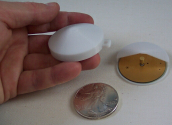April 17, 2003 – Wireless healthcare specialist Parco Wireless has opened a 4,000 square-foot facility to demonstrate the benefits of using new ultra-wideband technology for tracking assets in hospitals. The company says UWB technology has a number of advantages over conventional RFID, including the ability to transmit more data more quickly.
The Parco Wireless Solutions Center, built at the company’s headquarters in Portland, Maine, is a full-scale replica of a hospital suite comprising patient rooms and hallway, all built to industry specifications. “This is the only site in the US where the public can see UWB in action,” says Parco CEO Scott Cohen.
Parco will use the center to show how its UWB technology, licensed from Germantown, Maryland, specialist Multispectral Solutions, allows hospitals and emergency personnel to track the status and exact location of patients, caregivers, and essential equipment. The system comprises batterypowered UWB tags and antennas, as well Parco’s own asset management software.
UWB was developed by the US military and has seen little commercial use until it was cleared for commercial development by the FCC last year. Now, Parco Wireless believes it is set for deployment in a range of applications and industries.
UWB operates by emitting a series of extremely short pulses (billionths of a second or shorter) across a band of frequencies simultaneously. The FCC has cleared from 3.1 GHz to 10.6 GHz. Parco’s equipment uses the 6 GHz to 7 GHz band. UWB signals over these higher wavelengths can carry more information more quickly over a wider spectrum.
The signals are also better able to penetrate some dense materials, including walls. That, combined with very low power emission, makes UWB better suited than conventional passive tags to the tagging of assets in medical environments, according to Parco. “Passive tags bring an extraordinarily dangerous level of interference that can effect medical equipment,” says Cohen.
Parco’s UWB tags can transmit data at 100 kilobits per second, which means they can provide information on not just the location of equipment, but the status, including whether a medical device is switched on or off and how it is being used. Cohen says the company will increase the data transfer rate to 24 megabits per second within 24 months.
The tags are tracked by unique three-digit identification numbers emitted by each tag every second. With four UWB antennas placed at the perimeter of the demonstration center, Parco’s geospatial system can track tags in three-dimensions. Objects can be identified and located to within a sphere the size of a basketball.
According to Parco, four UWD antennas can cover a cell of 4,000 square-feet and up to 20,000 square-feet depending upon the nature of the building’s construction. The company has plans to release a multi-cell system by the end of the year.
Cohen says UWB RFID is best suited to continuous tracking of assets worth at least $100. That’s because UWB tags are noticeably larger and more expensive than passive RFID tags. Though not sold separately, the UWB would cost about $40 each. However, that cost would drop as the technology is more widely deployed.
Because of the broadband data capabilities of UWB, Cohen says tags could be used not only for inventory control during manufacture and shipping, but also for after-sale services that customers might be willing to pay for. One company XtremeSpectrum Inc. is pushing UWB for multimedia wireless applications in the home. In February this year, the company demonstrated to the FCC its ability to broadcast multiple high-definition television streams to large screen displays using UWB. Says Cohen: “If the customer pays for UWB because of the increased functionality, then it’s cheaper to the manufacturer than a 5 cent overhead for the RFID.”


